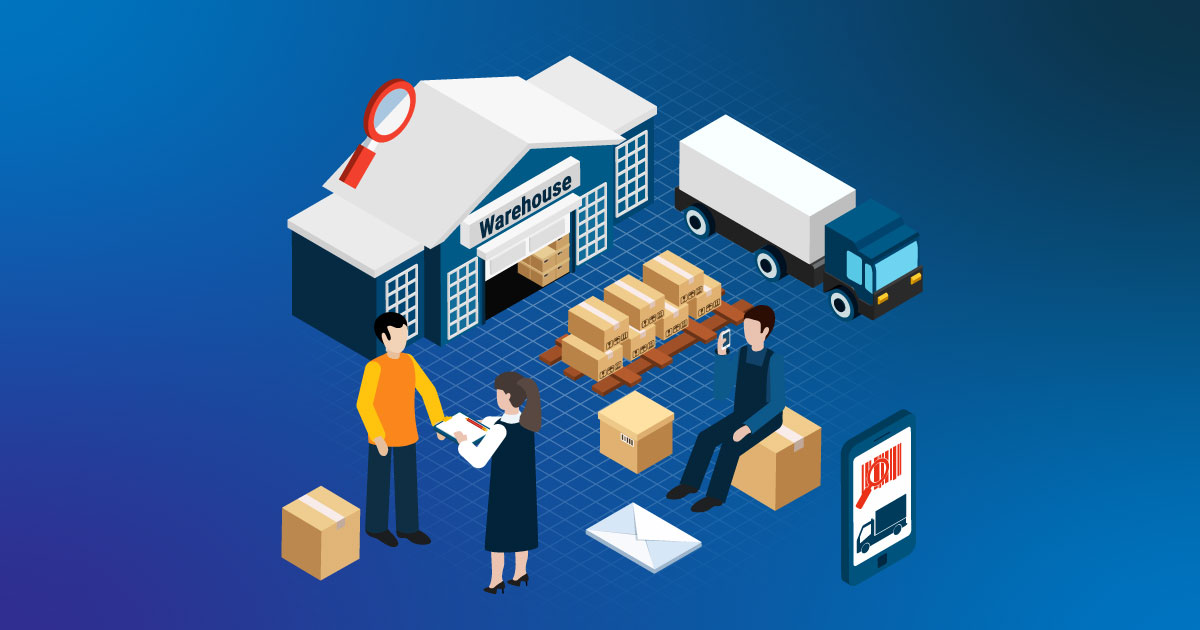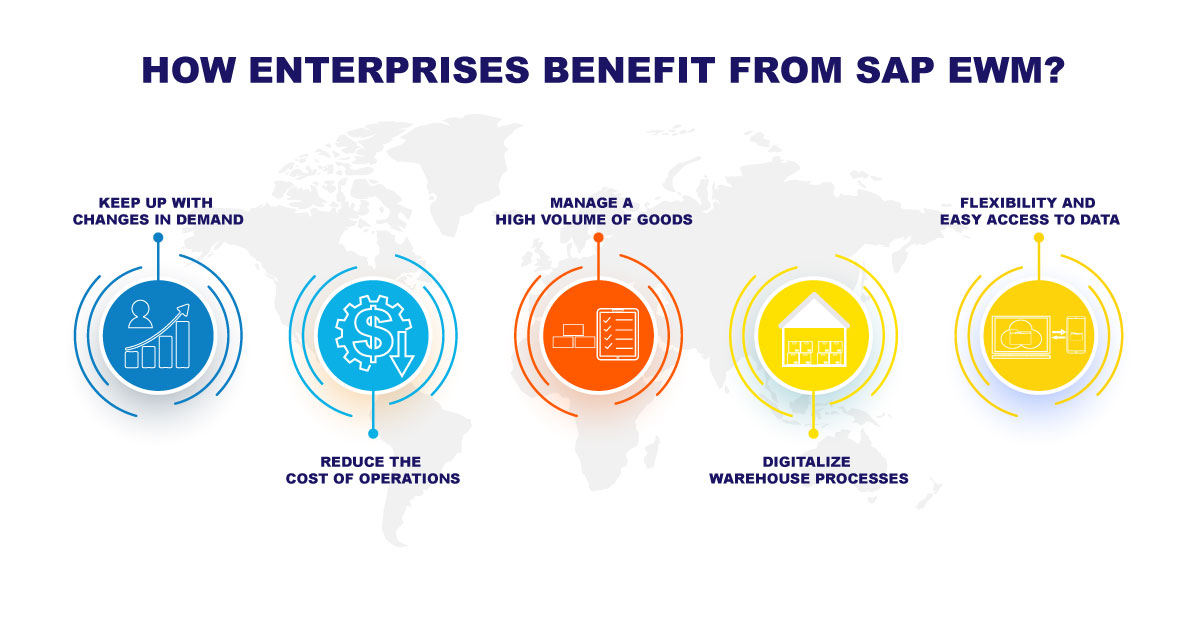Warehouse management is the process of optimizing and controlling the operations and storing products in the warehouse. It starts the entry of inventory to the facility and continues until it is sold, becomes obsolete, consumed, or moved to another location. Today, enterprises integrate warehouse management solutions with various types of BI and analytics to revamp and efficiently manage warehouse operations.
Modern warehouse management solutions represent a broader category of enterprise software with specialized tools for inventory, supply chain, and transportation management. A comprehensive warehouse management system with various features and functional requirements helps address some of the common challenges faced by businesses.
- Inaccurate inventory causes issues of maintaining improper stock levels and the build-up of obsolete inventory. These in turn lead to problems of inaccurate information and inefficient processes. Automated solutions offer real-time, accurate information about stock levels and composition.
- Traditionally, warehouse employees used to physically handle a product several times due to the nature of the warehousing process until the pandemic hit. With the spread of COVID-19, this time-consuming process became a health risk and required a rapid reassessment. Businesses realized that a warehouse management application with integrated barcode technology can streamline the warehousing process while maximizing resource utilization and minimizing physical contacts.
- Fluctuations in demand result in major cost problems for warehouses due to increased inventory levels that suppliers suddenly scrambled to fulfil. Timely and accurate information between the warehouse and other relevant entities or the industry can help the distributor to monitor and respond to changes in demand effectively.
- Warehouse managers strive to increase productivity while minimizing labor costs in a labor-intensive environment as these costs contribute significantly to the operating budgets of most warehouses. Labor shift has to be scheduled based on warehouse requirements. Managers also need to account for fluctuations in logistics while managing a vulnerable workforce. The two major strategies for addressing labor-related problems include maximizing available labor and replacing redundant resources with automated systems. An efficient warehouse management solution can help develop the right mix of expertise through workforce planning and helps managers hone the skills necessary for successful labor force practices.
- Poor picking is where most warehouse management problems occur as it can easily disrupt an inventory control system when the tasks are hurried up to assist an irate customer in a tense environment. Warehouse management solutions ensure full compliance with the system while bearing in mind the relevance of master data even when circumstances arise that make compliance seem counter-intuitive.
- A separate level of quality control will ensure better inventory management and bring down supply chain issues. The right warehouse management system offers the flexibility required to navigate any storm using cutting-edge technology. It also facilitates the transparent exchange of data, reduces risks and helps maintain a consistent, dependable warehouse where staff and customers can find maximum efficiency.

What is SAP EWM?
SAP Extended Warehouse Management (EWM) is a part of SAP SCM that provides end-to-end support for supply chain processes. It supports inventory management and the movement of goods in warehouses. The multi-client warehouse management solution was initially designed for large distribution centers with complex and highly automated processes. A warehouse can be mapped to the system down to the storage bin level and provides the advantage of a strong integration in the overall planning, collaboration, and visibility of supply chains.
Essentially, the SAP EWM application supports the entire warehouse logistics, the processing of all goods movements, and overall warehouse management. The focus is entirely on efficient logistics and optimal warehouse processes.
According to Forbes, SAP has partnered with Apple to develop a new mobile app that helps warehouses run smoothly and efficiently. The app – SAP Warehouse Operator allows workers to complete warehouse tasks using their iOS devices, available at the Apple App Store. The company is also planning to take warehouse automation to the next level with SAP Warehouse Robotics. Both are now part of SAP Extended Warehouse Management.
Embedded EWM in SAP S/4HANA
The Embedded EWM was later launched to help users to utilize the processing power of SAP HANA, thus reducing the total cost of ownership. The Embedded EWM is suitable for both small and medium-sized companies. Additional features can be purchased using a different license, allowing all users to enjoy the benefits of a reduction in ownership costs and ease of deployment.
The key advantage of SAP EWM is that it offers numerous possibilities for process automation in warehouse logistics and warehouse management. For instance, it is possible to map distances, including steps to optimize material flows. The entire process of product handling can be automated – from goods receipt and quality inspection to the final storage location.
SAP EWM is designed to track every unit of inventory down to the lowest level in a detailed manner for improved order fulfilment and inventory management. Gemini Consulting & Services can help enterprises in implementing SAP EWM for the efficient supply chain management. Contact us to know how your enterprise can leverage the capabilities of SAP EWM.

Main Capabilities of SAP EWM
- Features like inbound quality management, goods receipt management, transportation unit processing, and internal routing of products.
- Managing other physical inventory, re-arrangement, replenishment, stock management, slotting, etc within the business.
- Outbound processing functions, like goods issues, pallet planning, wave management, packing, staging, optimizing and cargo management.
- Deconsolidation of handling units before being sent to different storage sections.
- Systematic and optimized goods arrangement that helps determine storage accordingly.
- Tracking vehicles and other transportation units together with the movement of goods.
- Accurate tracking of hazardous substances.
Why SAP EWM?
- Using one system to track all activities such as tracking goods remotely, controlling equipment and integrating warehouse processes. This eliminates the necessity for multiple software solutions and hence reduces overall costs.
- With SAP EWM, the business obtains complete transparency over the operations like warehouse processes, labor, and stock information.
- It is feasible to manage inventory and facilitate hassle-free movement of goods by integrating production management and warehouse management.
- All business data is saved to the cloud and may be accessed by stakeholders remotely. Additionally, the software automates supply chain processes, decreases cycle times and sets up related operations. These help businesses make better decisions based on accurate data.
- Availability of a role-specific interface that permits employees to schedule the shipping of materials, implement adjustments, and track supply chain activities.
- SAP EWM is often deployed on an ERP server or can be considered as an app for supply chain management. SAP EWM is often integrated with the ERP systems to access master data and transaction information. Likewise, it is often integrated with CRM to offer availability checks and slotting.



